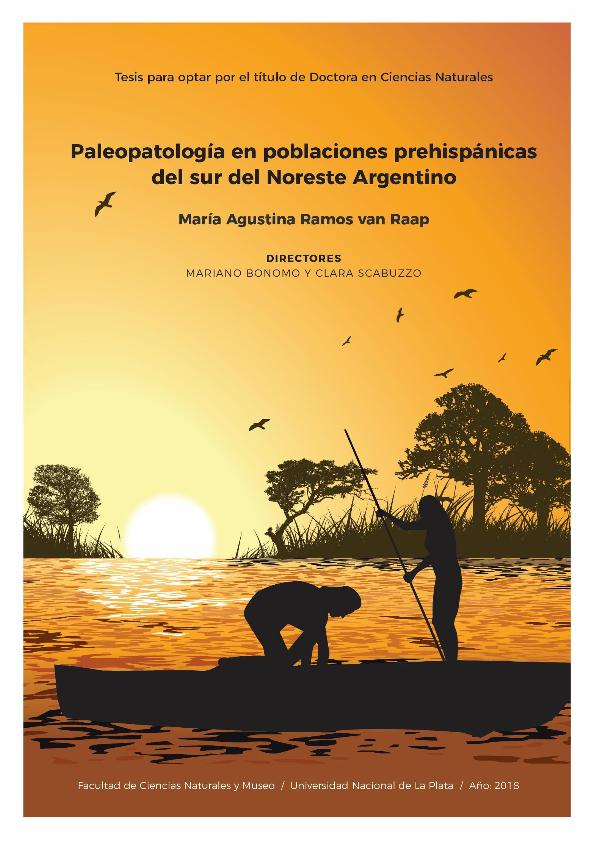Tesis doctoral
El objetivo principal de esta tesis es caracterizar la salud y la dieta de las poblaciones que habitaron el sur del Noreste Argentino durante el Holoceno tardío, a partir del análisis paleopatológico de distintos bioindicadores óseos y bucales. Los resultados obtenidos se integran con la información arqueológica disponible, con el fin de efectuar un estudio bioarqueológico integrador y así aportar al estudio de los modos de vida de los grupos prehispánicos que habitaron este sector.Los análisis se efectuaron en un número mínimo de 162 individuos, queproceden de tres muestras bioarqueológicas del Delta Superior del río Paraná, la cuenca inferior del río Uruguay y el Delta Inferior del río Paraná y ambientes litorales adyacentes. La primera de ellas, corresponde a dos sitios arqueológicos excavados recientemente como parte de los proyectos de investigación que enmarcan esta tesis. La segunda se constituye por los entierros humanos hallados, durante la segunda mitad del siglo XX, por Sr. M. Almeida en ocho sitios arqueológicos. La última muestra se conforma por los conjuntos óseos de un sitio excavado por Almeida y de dos sitios trabajados por L.M. Torres y S.K. Lohtrop a principios del siglo XX. Estas dos últimas muestras se encuentran bajo la guarda del Museo Arqueológico Manuel Almeida y del Museo de La Plata, respectivamente.Como resultado de esta investigación, los indicadores bucales observados en las tres muestras bioarqueológicas se ajustan a lo esperado para dietas mixtas. Los recursos animales constituyeron el componente principal de la alimentación, mientras que el consumo de vegetales fue una parte constitutiva importante y complementaria en la dieta. Se evidencian diferentes modos de procesar los alimentos, que atenuaron el estrés masticatorio. En la muestra de la cuenca inferior del río Uruguay, la dieta habría sido más abrasiva, relacionada principalmente con la molienda y el asado y cocción directa sobre el fuego. Por otro lado, el nucleamiento poblacional en las áreas residenciales con asentamientos semipermantentes (aldeas) y la ocupación durante los períodos de inundación en los lugares elevados del paisaje, habría incidido en la salud de las personas, quienes habrían estado expuestas a diferentes micro-organismos que favorecieron el desarrollo de enfermedades infecciosas. Finalmente, los escasos traumas relevados evidencian lo que las fuentes etnohistóricas reportan, en cuanto a la existencia de buenas relaciones entre los grupos étnicos locales llamados chaná-timbú, que habitaban el sur del Noreste Argentino. The main subject of this thesis is to characterize the health and diet of the populations inhabiting the south of the Northeastern Argentina over the Late Holocene, through the paleopathological analysis of bony and dental bioindicators. The results achieved are integrated with the available archaeological data, in order to carry out a holistic bioarchaeological study and thus contribute to the study of the prehispanic ways of life. The analyzes were performed on a MNI=162, coming from three bioarchaeological samples: 1) Upper Delta of the Paraná River, 2) Lower basin of the Uruguay River and 3) Lower Delta of the Paraná River and adjacent litoral environments. The first sample come from two archaeological sites recently excavated as part of the research projects that frame this thesis. The second sample is constituted by the sketetons found by Mr. M. Almeida in eight archaeological sites during the second half of the 20th century. The last sample consists of the skeletal assemblages coming from a burial site excavated by Almeida, and of two sites excavated by L.M. Torres and S.K. Lothrop at the beginning of the 20th century. The last two samples are under the custody of Museo Arqueológico Manuel Almeida and Museo de La Plata, respectively. The results of the analysis performed in this thesis shows that the buccal indicators of the three bioarchaeological samples match the expectations for mixed diets. Animal proteins were the main component of the diet, and the plants were important but complementary resourses. Different ways of processing food that eased the masticatory stress are evident. In the sample from the lower basin of the Uruguay river, the diet seemed to have been more abrasive as a result of grinding, roasting and direct cooking over the fire. On the other hand, population aggregation in residential areas with semipermanent villages and occupation of highlands during floods affected the health of people who were exposed to microorganisms that favored the infectious diseases. Finally, the few traumas surveyed seems to be congruent with the ethnohistoric sources which shows good relations among local ethnic groups named chaná-timbú that inhabited the south of the Northeastern Argentina.
Paleopatología en poblaciones prehispánicas del sur del Noreste Argentino
Ramos Van Raap, María Agustina

Director:
Bonomo, Mariano

Codirector:
Scabuzzo, Clara

Fecha de publicación:
12/10/2018
Idioma:
Español
Clasificación temática:
Resumen
Archivos asociados
Licencia
Identificadores
Colecciones
Tesis(CCT - LA PLATA)
Tesis de CTRO.CIENTIFICO TECNOL.CONICET - LA PLATA
Tesis de CTRO.CIENTIFICO TECNOL.CONICET - LA PLATA
Citación
Ramos Van Raap, María Agustina; Bonomo, Mariano; Scabuzzo, Clara; Paleopatología en poblaciones prehispánicas del sur del Noreste Argentino; 12-10-2018
Compartir



